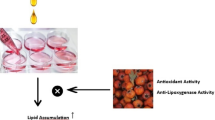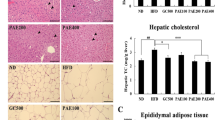Abstract
This study aimed to investigate the effects of ethanol extract of astringent persimmon on antioxidant activity, cholesterol, 3-hydroxy-3-methylglutaryl (HMG)-CoA reductase activity, and mRNA expression of cholesterol metabolism-related genes in human hepatoma cell line (HepG2 cells). In the results, DPPH and ABTS radical scavenging activity showed that the different types cultivars of astringent persimmon was similar to Vitamin C as positive control. However, there are not significant differences among samples. In addition, our results showed that cholesterol amounts and HMG-CoA reductase activity were inhibited by astringent persimmon in HepG2 cells. Further, treatment with astringent persimmon upregulated the expression of LDL receptor and SREBP-2, and also increased the level of HDL-associated ABCA1. Taken together, our results indicate that astringent persimmon regulate cholesterol accumulation by inhibiting the oxidative stress and controlling the levels of LDL & HDLassociated gene.
Similar content being viewed by others
References
Badimon L, Vilahur G, Padro T. Lipoproteins, platelets and atherothrombosis. Rev. Esp. Cardiol. 62: 1161–1178 (2009)
Badimon L, Storey RF, Vilahur G. Update on lipids, inflammation and atherothrombosis. Thromb. Haemostasis 105: S34–S42 (2011)
Sekalska B. Aortic expression of monocyte chemotactic protein-1(MCP-1) gene in rabbits with experimental atherosclerosis. Ann. Acad. Med. Stetin. 49: 79–90 (2003)
Vogiatzi G, Tousoulis D, Stefanadis C. The role of oxidative stress in atherosclerosis. Hell. J. Cardiol. 50: 402–409 (2009)
Halliwell B, Gutteridge JM, Cross CE. Free radicals, antioxidants, and human disease: where are we now? J. Lab. Clin. Med. 119: 598–620 (1992)
Loke WM, Proudfoot JM, Hodgson JM, McKinley AJ, Hime N, Magat M, Stocker R, Croft KD. Specific dietary polyphenols attenuate atherosclerosis in apolipoprotein E-knockout mice by alleviating inflammation and endothelial dysfunction. Arterioscl. Throm. Vas. 30: 749–757 (2010)
Wedworth SM, Lynch S. Dietary flavonoids in atherosclerosis prevention. Ann. Pharmacother. 29: 627–628 (1995)
Kang WW, Kim JK, Oh SL, Kim JH, Han JH, Yang JM, Choi JU. Physicochemical characteristics of Sang ju traditional dried persimmons during drying process. J. Korean Soc. Food Sci. Nutr. 33: 386–391 (2004)
Lee MH, No HK. Quality changes during storage of persimmon vinegar clarified by chitosan treatment. J. Korean Soc. Food Sci. Nutr. 30: 283–287 (2001)
Ohguchi K, Nakajima C, Oyama M, Iinuma M, Itoh T, Akao Y, Nozawa Y, Ito M. Inhibitory effects of flavonoid glycosides isolated from the peel of Japanese persimmon (Diospyros kaki 'Fuyu') on melanin biosynthesis. Biol. Pharm. Bull. 33: 122–124 (2010)
Briand CH. The common persimmon (Diospyros virginiana L.): The history of an underutilized fruit tree (16th-19th centuries). Huntia 12: 71–89 (2005)
Kawase M, Motohashi N, Satoh K, Sakagami H, Nakashima H, Tani S, Shirataki Y, Kurihara T, Spengler G, Wolfard K, Molnár J. Biological activity of persimmon (Diospyros kaki) peel extracts. Phytother. Res. 17: 495–500 (2003)
Kotani M, Matsumoto M, Fujita A, Higa S, Wang W, Suemura M, Kishimoto T, Tanaka T. Persimmon leaf extract and astragalin inhibit development of dermatitis and IgE elevation in NC/Nga mice. J. Allergy Clin. Immun. 106: 159–166 (2000)
Im CY, Jeong ST, Choi HS, Choi JH, Yeo SH, Kang WW. Characteristics of Gammakgeolli added with processed forms of persimmon. Korean J. Food Preserv. 19: 159–166 (2012)
Shin DS, Park HY, Kim MH, Han GW. Quality characteristics of bread with persimmon peel powder. Korean J. Food Cook. Sci. 27: 589–597 (2011)
Yoo KH, Kim SJ, Jeong JM. Effects of persimmon (Diospyros kaki Thunb.) syrup extracted from persimmon and persimmon by-products on blood glucose level. J. Korean Soc. Food Sci. Nutr. 40: 682–688 (2011)
Singleton VL, Rossi JA. A colorimetry of totalphenolics with phosphomolybdicphosphotungstic acid reagents. Am. J. Enol. Viticult. 16: 144–158 (1965)
Bubba MD, Giordani E, Pippucci L, Cincinelli A, Checchini L, Galvan P. Changes in tannins, ascorbic acid, and sugar content in astringent persimmons during on-tree growth and ripening and in response to different postharvest treatments. J. Food Compos. Anal. 22: 668–677 (2009)
Mensor LL, Menezes FS, Leitao GG, Reis AS, dos Santos TC, Coube CS, Leitao SG. Screening of brazilian plant extracts for antioxidant activity by the use of DPPH free radical method. Phytother. Res. 15: 127–130 (2001)
Re R, Pellegrini N, Pannala A, Yang M, Rice-evans C. Antioxidant activity applying an improved ABTS radical cation decolorization assay. Free Radical Bio. Med. 26: 1231–1237 (1999)
Denev P, Yordanov A. Total polyphenol, proanthocyanidin and flavonoid content, carbohydrate composition and antioxidant activity of persimmon (Diospyros kaki L.) fruit in relation to cultivar and maturity stage. Bulg. J. Agric. Sci. 19: 981–988 (2013)
Koh YJ, Cha DS, Choi HD, Park YK, Choi IW. Hot water extraction optimization of dandelion leaves to increase antioxidant activity. Korean J. Food Sci. Technol. 40: 283–289 (2008)
Gesquière L, Loreau N, Minnich A, Davignon J, Blache D. Oxidative stress leads to cholesterol accumulation in vascular smooth muscle cells. Free Radical Bio. Med. 27: 134–145 (1999)
Tian Y, Li CM, Yang J, Xu SF, Hagerman AE. High molecular weight persimmon tannin is a potent antioxidant both ex vivo and in vivo. Food Res. Int. 45: 26–30 (2012)
Gato N, Kadowaki A, Hashimoto N, Yokoyama S, Matsumoto K. Persimmon fruit tannin-rich fiber reduces cholesterol levels in humans. Ann. Nutr. Metab. 62: 1–6 (2013)
Schneider WJ, Goldstein JL, Brown MS. Partial purification and characterization of the low density lipoprotein receptor from bovine adrenal cortex. J. Biol. Chem. 255: 11442–11447 (1980)
Brown MS, Goldstein JL. The SREBP pathway: Regulation of cholesterol metabolism by proteolysis of a membrane-bound transcription factor. Cell 89: 331–340 (1997)
Briggs MR, Yokoyama C, Wang X, Brown MS, Goldstein JJ. Nuclear protein that binds sterol regulatory element of LDL receptor promoter. I. Identification of the protein and delineation of its target nucleotide sequence. J. Biol. Chem. 268: 14490–14496 (1993)
Edwards PA, Ericsson J. Sterols and isoprenoids: Signaling molecules derived from the cholesterol biosynthetic pathway. Annu. Rev. Biochem. 68: 157–185 (1999)
Quazi F, Molday RS. Lipid transport by mammalian ABC proteins. Essays Biochem. 50: 265–290 (2011)
Zhao Y, Pennings M, Hildebrand RB, Ye D, Calpe-Berdiel L, Out R, Kjerrulf M, Hurt-Camejo E, Groen AK, Hoekstra M, Jessup W, Chimini G, Van Berkel TJ, Van Eck M. Enhanced foam cell formation, atherosclerotic lesion development, and inflammation by combined deletion of ABCA1 and SR-BI in Bone marrowderived cells in LDL receptor knockout mice on western-type diet. Circ. Res. 107: e20–e31 (2010)
Rigotti A, Trigatti B, Penman M, Rayburn H, Herz J, Krieger M. A targeted mutation in the murine gene encoding the high density lipoprotein(HDL) receptor scavenger class B type I reveals its key role in HDL metabolism. P. Natl. Acad. Sci. USA 94: 12610–12615 (1997)
Krause BR, Auerbach BJ. Reverse cholesterol transport and future pharmacological approaches to the treatment of atherosclerosis. Curr. Opin. Investig. D. 2: 375–381 (2001)
Matsumoto K, Yokoyama S, Gato N. Hypolipidemic effect of young persimmon fruit in C57BL/6.KOR-ApoEshl mice. Biosci. Biotech. Bioch. 72: 2651–2659 (2008)
Dávalos A, Fernández-Hernando C, Cerrato F, Martínez-Botas J, Gómez-Coronado D, Gómez-Cordovés C, Lasunción MA. Red grape juice polyphenols alter cholesterol homeostasis and increase LDL-receptor activity in human cells in vitro. J. Nutr. 136: 1766–1773 (2006)
Mullen E, Brown RM, Osborne TF, Shay NF. Soy isoflavones affect sterol regulatory element binding proteins (SREBPs) and SREBP-regulated genes in HepG2 cells. J. Nutr. 134: 2942–2947 (2004)
Author information
Authors and Affiliations
Corresponding author
Rights and permissions
About this article
Cite this article
Hwang, KA., Hwang, YJ., Hwang, I.G. et al. Cholesterol-lowering effect of astringent persimmon fruits (Diospyros kaki Thunb.) extracts. Food Sci Biotechnol 26, 229–235 (2017). https://doi.org/10.1007/s10068-017-0031-4
Received:
Revised:
Accepted:
Published:
Issue Date:
DOI: https://doi.org/10.1007/s10068-017-0031-4




